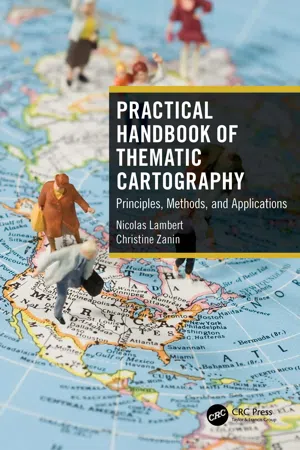
Practical Handbook of Thematic Cartography
Principles, Methods, and Applications
- 212 pages
- English
- ePUB (mobile friendly)
- Available on iOS & Android
Practical Handbook of Thematic Cartography
Principles, Methods, and Applications
About This Book
Maps are tools used to understand space, discover territories, communicate information, and explain the results of geographical analysis. This practical handbook is about thematic cartography. With more than 120 colorful amazing illustrations, numerous boxed texts, definitions, and helpful tools, this step-by-step introduction to cartography is both the art of understanding the world and a powerful tool for explaining it. Through many hands-on tests, the reader will learn how to produce an interesting and communicative map applied to any spatial theme.
Written by experienced scholars and experts in cartography, this book is an excellent resource for undergraduate students and non-cartographers interested in designing, understanding, and interpreting maps. It includes practical exercises explained in the form of a game and provides a concise, accessible, and current address of cartographic principles, allowing readers to go deeper into cartographic design. It can be read from beginning to end like an essay or just by dipping into it for information as needed.
Frequently asked questions
Information
Part 1
Geographical Information
After having told young children that the Eartha is round, that it is a ball rolling through space like the sun or the moon, can I then show them an image in the shape of a rectangular sheet of paper with colored images? […]Should I try to make these little ones understand that the sphere has been changed into a planisphere (flat world map) – in other words, if I correctly understand the two juxtaposed words, a flat sphere?
Introduction
- Geo-referencing consists in positioning or marking by hand an object on a reference basemap. This operation can be conducted with the computer mouse, identifying the place to be referenced by a click, or by entering the geographic coordinates of the object if these are available directly, using the keyboard. Adjusting an image involves positioning exactly an object (such as an aerial photograph), so as to superimpose it on the basemap. Geo-referencing can also be performed directly in the field using a GPS device.
- Geocoding consists in attributing geographic coordinates (longitude, latitude) to an address. To do this, a database is required giving references for each section of road, along with tools to exploit the database. These geocoding systems, which were for a long time on offer on the market, are now available, free of charge. For the USA, the website https://www.census.gov makes it possible to geocode addresses across the national territory via an online application.
- Reference information concerns general data that can be used in numerous areas of activity: administrative boundaries, road networks, countries across the world, etc. A lot of this information is freely available online.
- Thematic information concerns particular themes. It can be produced by businesses, study bureaus, or specialists of one or other domain. This information is more specialized and generally come at a cost. Today, the open data movement is facilitating access.
- Geometric information, formed by points, lines, and polygons, describes the shape, the contour, and the localization of objects within a system of geographical or Cartesian coordinates. This is the basemap (Chapter 1).
- Semantic information, made up of numerical values or text, relates to an object that is localized in space. It can be the name of a street, a plot number, or statistical information concerning the particular territorial unit (e.g., the number of inhabitants in Cherokee County (North Carolina). This type of data is often known as attribute data (Chapter 2).
- Topological information is information deduced from the geometrical information. It is defined by spatial relationships between objects: proximity, distance, contiguousness, inclusion, etc. It can generate specific cartographic representations such as discontinuities, multi-scalar typologies, or smoothing.

Table of contents
- Cover
- Half Title
- Title Page
- Copyright Page
- Table of Contents
- Foreword
- Authors
- General Introduction
- Part 1 Geographical Information
- Part 2 Cartographical Language
- Part 3 Beyond the Visual Variables
- General Conclusion
- Annexes
- Bibliography
- Index